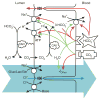Cation-coupled bicarbonate transporters
- PMID: 25428855
- PMCID: PMC4768804
- DOI: 10.1002/cphy.c130005
Cation-coupled bicarbonate transporters
Abstract
Cation-coupled HCO3(-) transport was initially identified in the mid-1970s when pioneering studies showed that acid extrusion from cells is stimulated by CO2/HCO3(-) and associated with Na(+) and Cl(-) movement. The first Na(+)-coupled bicarbonate transporter (NCBT) was expression-cloned in the late 1990s. There are currently five mammalian NCBTs in the SLC4-family: the electrogenic Na,HCO3-cotransporters NBCe1 and NBCe2 (SLC4A4 and SLC4A5 gene products); the electroneutral Na,HCO3-cotransporter NBCn1 (SLC4A7 gene product); the Na(+)-driven Cl,HCO3-exchanger NDCBE (SLC4A8 gene product); and NBCn2/NCBE (SLC4A10 gene product), which has been characterized as an electroneutral Na,HCO3-cotransporter or a Na(+)-driven Cl,HCO3-exchanger. Despite the similarity in amino acid sequence and predicted structure among the NCBTs of the SLC4-family, they exhibit distinct differences in ion dependency, transport function, pharmacological properties, and interactions with other proteins. In epithelia, NCBTs are involved in transcellular movement of acid-base equivalents and intracellular pH control. In nonepithelial tissues, NCBTs contribute to intracellular pH regulation; and hence, they are crucial for diverse tissue functions including neuronal discharge, sensory neuron development, performance of the heart, and vascular tone regulation. The function and expression levels of the NCBTs are generally sensitive to intracellular and systemic pH. Animal models have revealed pathophysiological roles of the transporters in disease states including metabolic acidosis, hypertension, visual defects, and epileptic seizures. Studies are being conducted to understand the physiological consequences of genetic polymorphisms in the SLC4-members, which are associated with cancer, hypertension, and drug addiction. Here, we describe the current knowledge regarding the function, structure, and regulation of the mammalian cation-coupled HCO3(-) transporters of the SLC4-family.
Figures













References
-
- Aalkjaer C, Mulvany MJ. Steady-state effects of arginine vasopressin on force and pHi of isolated mesenteric resistance arteries from rats. Am J Physiol. 1991;261:C1010–C1017. - PubMed
-
- Abuladze N, Lee I, Newman D, Hwang J, Boorer K, Pushkin A, Kurtz I. Molecular cloning, chromosomal localization, tissue distribution, and functional expression of the human pancreatic sodium bicarbonate cotransporter. J Biol Chem. 1998;273:17689–17695. - PubMed
Publication types
MeSH terms
Substances
Grants and funding
LinkOut - more resources
Full Text Sources
Other Literature Sources

